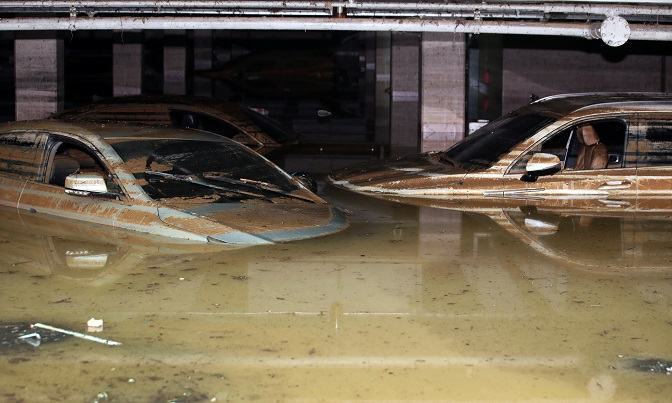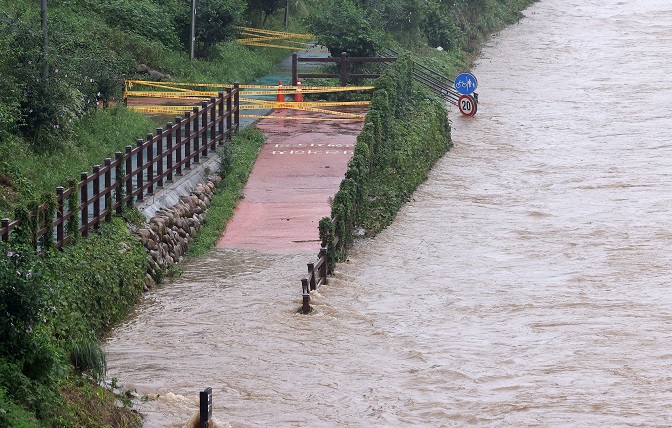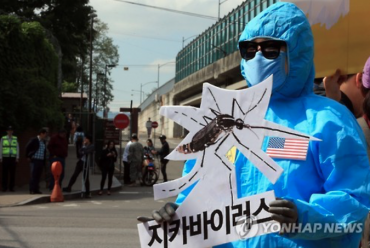
A village in Hadong, South Gyeongsang Province, is submerged by overflow from the Seomjin River on Aug. 8, 2020, due to two days of torrential rain. (Yonhap)
SEOUL, Aug. 9 (Korea Bizwire) — Floods and landslides triggered by heavy downpours in South Korea’s central and southwestern regions have killed 31 people and left 11 others missing in just over a week, forcing more than 6,000 to evacuate, authorities said Sunday.
The country remains on high alert as search and recovery efforts continue and is bracing for an approaching typhoon likely to reach the peninsula early this week.
Torrential rains that started on Aug. 1 have wreaked havoc on Seoul and its surrounding Gyeonggi Province; the central Chungcheong and southwestern Jeolla Province, causing massive flooding and destroying roads, houses and farmland.
According to data from the Central Disaster and Safety Countermeasure Headquarters, as of 7:30 p.m., 13 people have been killed since Friday in accidents caused by the rain and two others have gone missing. More than 3,700 people have been displaced.
The death toll did not count the casualties from three capsized vessels at Uiam Dam in Chuncheon, 85 kilometers east of Seoul, which left three dead and three missing on Sunday. It was categorized as a marine accident.
Some 23,000 hectares of farmland were swamped or buried, while 13,370 cases of damage to public and private facilities were reported, according to the authorities.

An underground parking lot of an apartment complex in Gwangju, 329 kilometers south of Seoul, is flooded on Aug. 9, 2020. (Yonhap)
Typhoon Jangmi, the season’s fifth typhoon, is forecast to hit the southern region of the peninsula on Monday, passing waters off the southernmost island of Jeju and arrive in waters off the southern port city of Busan.
The KMA said the typhoon is likely to bring a rainfall of up to 300 mm.
The KMA advised people on the southeastern seaside to take extra precautions and be prepared for dangerous tides, possible flooding or landslides.
On Sunday, a landslide buried a house in the county of Jangsu, North Jeolla Province, killing two people. A man in his 70s went missing as he was swept away by a strong current in Damyang, South Jeolla Province.
In the southwestern city of Gwangju, rain flooded the basement of a private ossuary where some 1,800 urns were deposited. Little damage was done to the urns as the windows remained intact, according to officials.
The disaster authorities said seven railways across the country were blocked as of Sunday morning. All flights at Gwangju Airport resumed early Sunday after having been suspended.
As downpours continued to trounce the country’s metropolitan and central regions, parts of Seoul’s major expressways along the Han River were closed to traffic.
The river’s water level rose to dangerous levels due to the increased discharge of water from dams, including Paldang Dam, in upper reaches.
The disaster control center expanded landslide warnings and advisories to 81 counties and cities across the nation as heavy rains continued to batter the country. The Korea Forest Service said 667 landslides have been reported so far.
Since Friday, Seoul has received more than 150 mm of rain, with Damyang recording 612 mm, 533.7 mm in Gwangju and 517.5 mm in Hwasun County.
The disaster control center said 3,749 people have been left homeless over the three-day period, most of which are still staying at temporary shelters due the flooding of the Seomjin River in Namwon City, North Jeolla Province, and Gurye and Damyang counties, both located in South Jeolla Province.
Nearly 3,300 cases of property damages were reported over the cited period, including to 2,233 public facilities, while damage was also reported to 287 residences and 1,180 hectares of farmland.
Last week, the government designated seven cities and counties in central South Korea, including Anseong of Gyeonggi Province, Cheorwon of Gangwon Province and Chungju of North Chungcheong Province, as special disaster zones due to heavy rainfall.
Those regional governments are eligible for state financial support for their disaster recovery efforts, while residents can receive reductions in utility bills, health insurance premiums and other public charges.
On Sunday, the governor of South Jeolla Province asked the central government to designate some cities of the province hit by recent downpours as special disaster zones as well.
(Yonhap)







